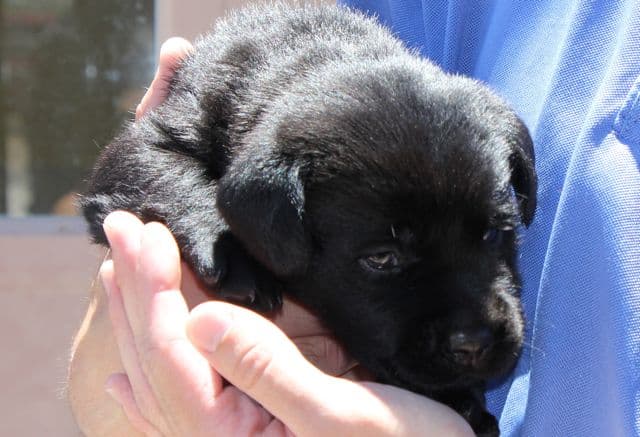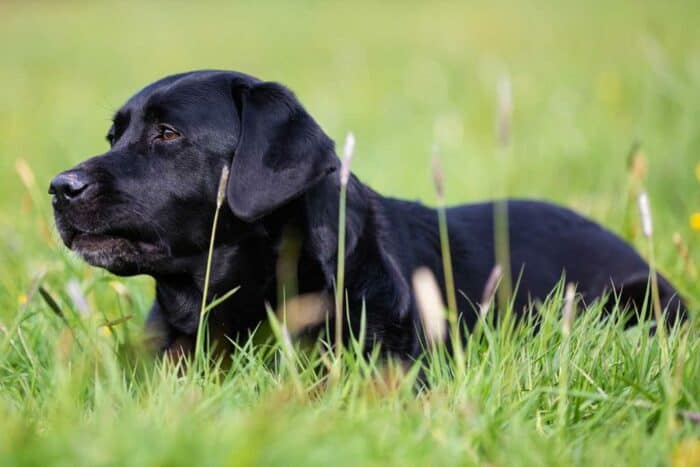English Black Labrador Retrievers – Need To Know!
This post may contain affiliate links. We may earn money or products from the companies mentioned in this post.
An English black Labrador is a specific color variant of the English Labrador retriever.
Even though they are technically the same breed, the English Labrador differs in some important ways from the American Lab.
Black Labs are actually the most common color, as four out of nine potential gene combinations result in a black coat.
If you see an English black Lab up for sale or adoption, should you take them home?
These dogs make fantastic pets for the right type of pet owner.
Read on to find out why and decide whether they are the right new pup to introduce into your family.
Vital Statistics
- Type: Purebred
- Weight: 55 – 80 pounds
- Height: 21.5 – 24.5 inches
- Coat: Black (yellow and chocolate variations also exist), high shedding
- Lifespan: 10 – 12 years
- Intelligence: Highly intelligent and trainable
- Temperament: Friendly and affectionate
- Energy Level: High
FULL DISCLOSURE: I’ve had black Labs entire life so I might be a little biased. I HEART regular, mixed, English (all types) of black Labs!
History Of The Breed
While today you can find both American and English Labrador retrievers, they were initially bred in the United Kingdom as retriever gun dogs.
However, they were bred from stock imported from Canada and are therefore named for the Labrador region of that country.
Even in the early days of breeding in the 1800s, Labradors were more likely to be black than any other color.
Labradors are often seen as working dogs and are a popular breed for guide dogs.
My first guide dog puppy in training, Stetson was an English black Labrador Retriever!

They seem to learn the required skills faster than other popular working dog breeds, such as German Shepherds and Golden Retrievers.
Notably, Labradors can be taught to complete very complex tasks.
One Lab named Endal was trained to assist their wheelchair-bound human into the recovery position if necessary, cover him with a blanket, and activate an emergency telephone.
Appearance
Labrador retrievers are considered medium-to-large dogs.
The females measure 21.5 to 23.5 inches in height and weigh 55 to 70 pounds, while the males are slightly bigger and measure 22.5 to 24.5 inches and weigh 65 to 80 pounds.
Labradors have a short, dense double coat that repels water and sheds heavily.
The dog has a sturdy and muscular physique with a fairly broad head and rectangular ears.
You can tell the difference between an English Lab and an American Lab because English Labs tend to be stockier with more square heads, while American Labs have lankier physiques and thinner faces.
Labrador retrievers come in three colors: yellow, brown, or black.
English black Labs are, of course, always black.
This is actually the most common color for Labrador retrievers, with four in nine pups coming out black on average.
Of course any reputable Labrador Retriever breeder can match their stud and dam to produce an all black litter if that was their preference. Same for an all yellow or all chocolate litter.
DID YOU KNOW: Okay, we know Labs come in 3 colors. However, did you know that Labs can also have “black and tan” and “brindle” coloring? This is due to a recessive gene that each parent must contribute.
When I first started raising guide dog puppies we had several black and tan pups including Escort and Eagan.
Temperament
Labrador retrievers are extremely intelligent and extremely friendly, which is the perfect combination in a canine companion.
Labs are considered among the most intelligent breeds, and they are also eager to please. This makes them highly trainable because they are easily driven by reward.
They may only need to hear a command two or three times to understand what is wanted from them in combination with positive reinforcement.
They also have a strong work ethic and can concentrate on a task for extended periods of time.
They are also naturally friendly dogs that bond quickly with their families.
However, while they are loyal, they do not have the tendency to bark at any human or animal that is not part of their family that some dogs have.
This means Labrador retrievers typically make terrible guard dogs, since they are more likely to make friends with a stranger than raise the alarm.
Still, they do well in households with kids and other animals, especially if properly socialized from a young age.
However, since they love their families so much, your Lab won’t be happy to be excluded from family activities!
They will want to be in the house with their families, including on the couch and in the bed.
They also don’t do well if they are left alone for extended periods of time on a regular basis.
They need to be around people and can develop destructive separation anxiety if they are left alone too often.
Exercise
Labrador retrievers are energetic dogs, and they need lots of exercise to stay healthy and happy.
While they should never be “outside only” dogs, they should have an outdoor space to call their own where they can blow off steam.
QUICK TIP: While it is recommended to have an outdoor space it’s not totally necessary. If you’re prepared to walk and exercise your dog several times a day an outdoor space is not necessary.
In addition to this, they need at least an hour of more intensive exercise per day. This means a run rather than a walk and playing a game of catch or tug.
But remember, while adult Labs need lots of exercise, it is easy to over-exercise these dogs when they are puppies.
This can lead to malformation of the joints that can be painful in later life. Puppies should only have about five minutes of exercise a day per month of life.
This means a four month old puppy needs just 20 minutes, which should boost to 30 minutes when they hit six months.
Adult English Labs love active families they can go hiking with. Labs also live swimming and getting in the water.
If you decide to take them out on a boat, don’t forget their doggy life jacket.
Health And Care

Labrador retrievers are generally healthy dogs, but like all purebred dogs, they can be prone to certain health conditions.
This is the result of generations of inbreeding that has occurred to develop the breed.
While breeders try to prevent inbreeding today, some conditions are well-established within the gene pool.
Labradors can be particularly prone to hip and elbow dysplasia, with the chances of these issues increasing if they are over-exercised when young.
They can also be prone to eye conditions such as progressive retinal atrophy and cataracts.
THE MORE YOU KNOW: We are currently raising guide dog puppy, Anna. At one year old her whole litter went to the vet office for an eye exam. Unfortunately, one of her nine siblings was dropped from the program due to cataracts.
Another big problem for English black Labs is obesity because they don’t have the appetite-regulating proopiomelanocortin gene. Hmmm…I’m going to have to check and see if I’m missing that gene…
This means they are never full!
We’re definitely talking about my black Lab, Elsa!
So it is up to you to control your Lab’s calorie intake. Labs need good-quality food that is high in animal-based protein with plenty of healthy animal fats.
This will give them the energy they need to get through their busy day without the need for excessive calories.
Labradors should also be brushed daily to help remove hair from their high-shedding coats.
While it is tempting to give them a good wash on a regular basis, this can actually damage their coats and make their shedding worse.
It is best to try to limit shampoo sessions for your dog to once a month. This may not be possible if you have an active dog who loves to romp through the mud but do your best.
You can always rinse them down and give them a brush if they seem to have picked up excessive debris between washes.
Read our guide to how to bathe a puppy here.
American vs. English Labs
Before wrapping up, it is worth making a note of the differences between the American and English Labs.
As we have already noted, English Labs tend to be stockier with rounder heads.
This is because while American Labs were bred principally for working in the last 100 years, English Lab breeding was focused on conformation and alignment with breed specifics.
This means English Labs are preferable for pet owners looking for show dogs.
Also due to this breeding preference, American Labs tend to have a little bit more energy than their English counterparts.
English Labs are often characterized as calmer and quieter, but the overall difference between their two temperaments is minimal.
Getting A Black Lab Puppy
Labrador retrievers are extremely popular. This means there are a lot of breeders working with them, but it also means demand is high.
Prices vary greatly depending on supply and demand, and you can expect to pay anything from $400 to $1,500 for a Lab pup from a respectable breeder.
MY RESEARCH: Since the pandemic I’ve seen the prices of puppies sky rocket. I was researching a black Lab puppy between 2019 and 2023. The highest price pups were over $4,000! Yowzers!
In general, it is not hard to come across black puppies, since they are the most common color. Litters often have a mix of colors among the puppies.
Despite being dogs that are relatively easy to care for, you will often find black Labs in shelters and rescues.
Not everyone is prepared for the responsibility of looking after a dog, so puppies will often find themselves in search of a new home.
So, if you are looking for a black Lab, make sure to check with local shelters first.
FAQs About English Black Labs
What is the difference between an English Lab and a black English Lab?
A black English Lab is one of the three color variations of English Labrador retrievers. The others are yellow and chocolate.
Black is the most common color for Labradors.
Are English Labs calmer?
Due to historic breeding practices, English Labs are considered to be a little calmer than their American counterparts.
However, the difference is inconsistent and negligible and should generally not be a major factor when choosing a puppy to adopt.
Should You Adopt An English Black Lab?
English black Labs are friendly and intelligent dogs that are great for first-time owners and families. Still, deciding whether to actually adopt one is a big responsibility.
Like many large breeds, they need lots of love and attention. That means at least an hour of exercise a day and plenty of time around their family.
They don’t do well when left alone for extended periods each day.
If you have an active lifestyle and the time to spend with a canine companion, bringing home a black English Lab will be a highly rewarding experience.
Finally, to recap, here are the breed’s key stats at a glance once more:
- Type: Purebred
- Weight: 55 – 80 pounds
- Height: 21.5 – 24.5 inches
- Coat: Black (yellow and chocolate variations also exist), high shedding
- Lifespan: 10 – 12 years
- Intelligence: Highly intelligent and trainable
- Temperament: Friendly and affectionate
- Energy Level: High
Final Thoughts
We love English black Labs! Ummm…our first guide dog puppy, Stetson was an English black Lab. Nuff said!
Seriously, we’ve had black Labs (mixed, American, English, or other) throughout our lives. Here’s the short list:
- Maffy – Border Collie Lab Mix
- Linus – Australian Shepherd Lab Mix
- Stetson – English Black Lab
- Elsa – Black lab
That’s not to mention the many black Labs we puppy sat for the guide dog school.
If you’re looking to get an English black Lab, I give you the thumbs up.
So, have you ever had an English black Lab?
If so, tell us about your dog in the comment section below.
Related Article:
Save To Pinterest

Top Picks For Our Puppies
- BEST DOG CHEW
We Like: Beef Collagen Sticks - All of our pups love to bite, nip, and chew. We love using Collagen Sticks to help divert these unwanted behaviors. - BEST PUPPY TOY
We Like: Calmeroos Puppy Toy w/ Heartbeat and Heat Packs - Perfect for new puppies. Helps ease anxiety in their new home. - BEST DOG TREATS
We Like: Crazy Dog Train-Me Treats - We use these as our high-value treats for our guide dog puppies. - BEST FRESH DOG FOOD
We Like: The Farmer's Dog - A couple months ago we started feeding Raven fresh dog food and she loves it! Get 50% off your first order of The Farmer's Dog.
Check out more of our favorites on our New Puppy Checklist.
